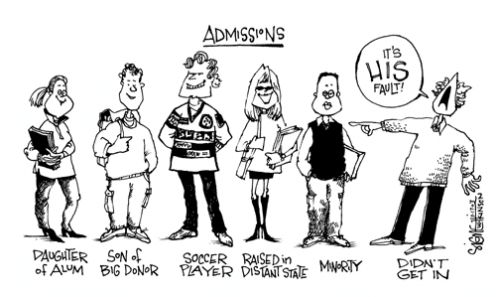Affirmative Action: Equal Opportunity or “Reverse” Discrimination?
Arguments Against Affirmative Action Often Lack Statistical Support

Affirmative Action is usually not to blame for unfair admittance policies. Photo courtesy of Google Images.
October 13, 2015
Affirmative Action is a controversial topic among high school students. As students are applying for colleges and choosing career paths, many are considering the impact Affirmative Action may have on their opportunities.
Affirmative Action was first enacted by President John Kennedy in 1961 by Executive Order 10925. Government offices and agencies were ordered to “take affirmative action to ensure that applicants are employed, and employees are treated during employment, without regard to their race, creed, color, or national origin.” The purpose of this order was to “affirm the government’s commitment to equal opportunity for all qualified persons,” and work to create a more fair workplace for U.S.citizens. In 1965, President Lyndon Johnson extended upon this order, prohibiting companies from discriminating against potential employees based on all of the previously listed traits. He also added religion and gender onto the list.
Eventually, Affirmative Action branched out to colleges and universities as well. Government officials realized that equal opportunity employment was nearly impossible without equal opportunity in education as well.Qualities such as race, religion, sex, color, ethnicity, and national origin were not to be considered in the admissions process.
Upon this order, high school students are divided. College is approaching and the distribution of opportunities is more important to us now than ever. This causes factions in the issues, as some students applaud Affirmative Action and some want its repeal.
Most high school students’ arguments against Affirmative Action usually circle around the idea that the order creates an unfair advantage where students of color are prioritized over white students for not only admittance, but also financial aid in universities and colleges. This idea is simply untrue. Approximately 21 million students apply for financial aid. Over 76% of the students granted institutional merit-based scholarships are white. According to the University of Arizona’s Nolan L. Cabrera, Ph,d., white students are 40% more likely to receive financial aid than students of color. Where white students make up about 62% of undergraduates, they receive approximately 69% of private scholarships. However, where minorities make up 38% of undergrads,they receive only 31% of private scholarships. This disproportionate distribution of funding suggests that the system is, in fact, unfair, just not in the way many white students believe it to be. Even with Affirmative Action and minority-based scholarships, white students have the financial advantage.
Another argument explores the idea that minority-based scholarships compose the overwhelming majority of private scholarships, and therefore create disproportionate opportunities–a sort of “reverse discrimination” system where whites are the victims and minority students have it easy in terms of paying for school. This as well is untrue, as Cabrera has explained white people are eligible for about 96% of all scholarships. Furthermore, with only about 4% of these scholarships having anything to do with race, the few that do exist are extremely competitive as millions of students of color compete for very limited scholarships.The idea that it is somehow “easier” for minorities to receive financial aid is clearly not based on fact, but on a misunderstanding of competitive, private scholarships.
Others see Affirmative Action as some sort of unnecessary reparation to people of color. However, according to TIME Magazine, the group which has benefited the most from Affirmative Action is white women.
Even when these statistics are presented to opposers of Affirmative Action, there is still the argument that the order is divisive and unnecessary in the modern society.Many see a decrease in discriminatory instances to mean that measures designed to prevent discrimination are now obsolete.The Supreme Court has ruled that states may do away with race-based Affirmative Action, and states like California, Washington, and Michigan have done so.
The argument that a decline in racially based discrimination justifies the dismissal of a protective order is flawed and demonstrates the large racial disconnect in this country. One of the main reasons discrimination is dwindling is because of Affirmative Action. A report from the U.S. Labor Department has identified Affirmative Action as the catalyst which has led to 5 million minority members and 6 million White and minority women moving up in the workforce. Taking away Affirmative Action due to this reasoning would be similar to putting a cancer patient on chemotherapy, noticing the therapy is effective, and therefore taking the patient off before the body is ready to survive without treatment.Affirmative Action is a treatment for the discrimination tumor, and although it has shrunk considerably, America is far from remission, so it is foolish to think we’ve been cured.
The truth is Affirmative Action does not work to reward minorities, but to level the playing field. It is an order that works to make America the free and fair nation we all like to think of it as.



Emily Roach • Oct 29, 2015 at 3:49 pm
Another great piece. Keep up the good work.